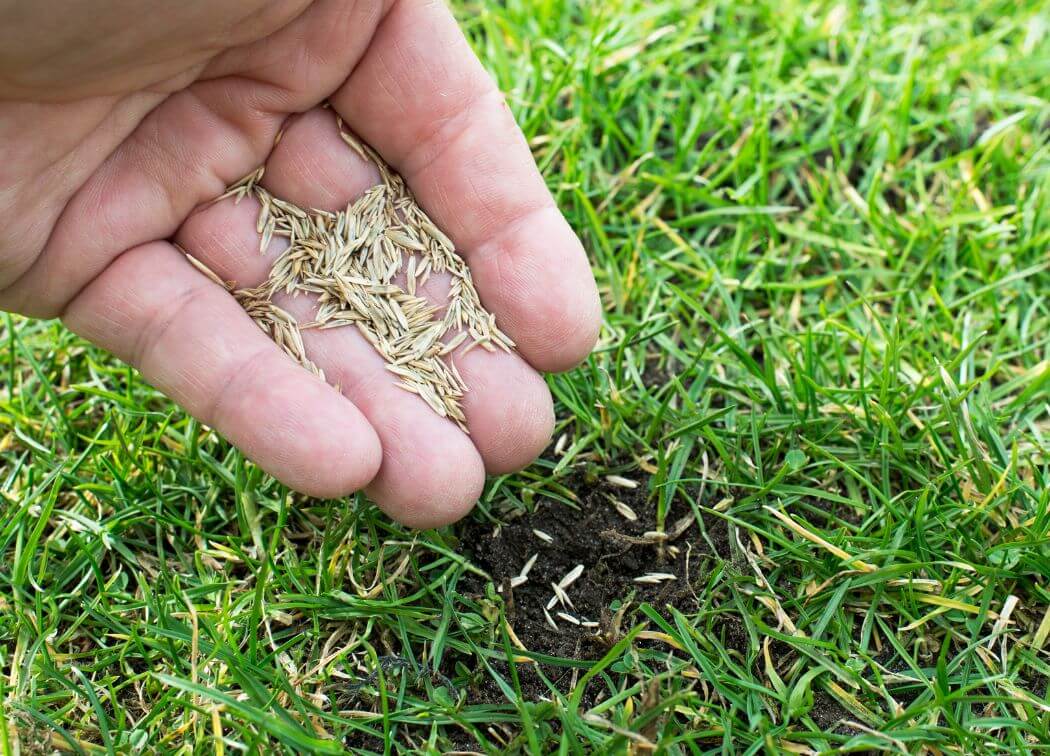Nobody wants to see their beautiful Bermudagrass lawns thinning before their very eyes. You will need to replace the balding with new grass seedlings. Overseeding is the way to go.
Overseeding your Bermuda lawn allows it to grow denser, reinforcing pre-existing Bermuda grass with additional Bermuda seeds. You need to keep track of your lawn’s season and soil temperature for the best results.
Overseed Bermudagrass lawns between mid-spring to early summer when soil temperatures reach 60 degrees. This helps with seed germination, as the timing and soil temperature are ideal for most warm-season turfgrasses. Overseed in a uniform manner across the whole yard.
However do not overseed your Bermuda lawn if it hasn’t been established for at least 90 days.
Let’s go through some steps to take when overseeding this warm season grass and its cool-season grass varieties in the winter months. We will look at the best Bermuda Grass types to overseed your lawn with.
When to Overseed a Bermuda Grass Lawn
Bermuda Grass is generally warm-season grass, preferring heat and favoring sunlight. The proper time to overseed Bermuda is from mid-spring to early summer. This is the peak growing season for Bermuda and other warm-season grass species.
The early spring brings about the soil temperatures needed for seedling establishment and growth, allowing you to add Bermuda seeds that can germinate and get proper root development.
Spring brings new growth when the snow melts and the cold passes into heat. Bermuda Grass has low cold tolerance, so overseeding when the weather grows warm means unimpeded seed germination.
Planting Bermuda seeds during this growth season is also essential, as planting beforehand can slow down your germination rate. When you plant in mid-spring, your Bermuda grass lawn will take less than a week to germinate.
When spreading your Bermuda Grass in spring, you can have a new lawn area in one-and-a-half months. In less-than-ideal conditions (winter), new seedlings can take three weeks to germinate and 8-10 weeks to develop.
Lastly, it’s important not to overseed your Bermuda lawn if it hasn’t been established for 90 days. This is the minimum amount of time for Bermuda rhizomes (underground shoots) for maximum growth rate.

How to Overseed Bermuda Grass
To overseed grasses and plant new grass seedlings on your Bermuda Grass lawn, you will first need to core your lawn area a few weeks before.
You can then use a rotary spreader to send the seeds out evenly over the soil surface. It is highly recommended to set the spreader to release a few seeds as you move through the lawn.
The rotary spreader allows its nutrients to spread uniformly, which is ESSENTIAL if you’re overseeding your Bermuda lawn with Ryegrass variety.
Ryegrass lacks lateral shoots and is not powerful enough to facilitate spreading into bare spots on your lawn.
The rotary spreader can evenly release seeds in set amounts, allowing you to control the spread uniformly. Your grasses can grow thick and evenly.
This is important when using perennial ryegrass seed varieties, as these lack lateral shoots for filling bare spots independently. You will need to fill in gaps to prevent weeds from sprouting.
When overseeding Bermuda Grass exposed to heavy foot traffic like those on golf courses, you will need to include a sand mix topdressing to speed up turf establishment when seeding. You can then rake them to the soil level.
Grass Mix: What Grass Can You Overseed With?
For uniformity, using similar Bermuda when planting new seedlings works best. Normal Bermuda seed grows best from mid-spring to summer.
However, you will need a mix of Ryegrass and other grasses to build a more resilient, denser and greener lawn. You may need a different kind of grass for the winter months.
Here are some of the best Ryegrass and cold season grass seed options when seeding your lawn.
Annual and Perennial Ryegrass

Bermuda is a warm-season grass. It will wilt and die in the cold. If you want to avoid the headache of looking out at a dead, brown lawn, you can switch to cool-season ryegrasses, including perennial (seasonal) and annual Ryegrass.
Annual ryegrass seeds are cheaper but offer poor heat resistance and die in mid-summer heat. Perennial ryegrass seed is the opposite. It is expensive but reliable, and it will give you a consistent green throughout the year.
When overseeding with annual ryegrass seed and Perennial Ryegrass, you will also need to consider looks and color. Perennial ryegrass seeds are more aesthetically pleasing to look at.
However, when choosing the seed that grows faster, you can’t go wrong with annual Ryegrass. It will have your lawn looking spic and span in a few weeks, much faster than perennial.
Turf Star Ryegrass Seed works best in this case, offering a deep, rich green look popular in sports and homes. It makes for an ideal winter companion, the best cold-season turf grass for your lawn.
Once winter ends, ryegrasses can become weeds in your lawn, overtaking Bermuda. It will absorb resources and choke out your Bermudagrass lawns. It will also expose your lawn to diseases and fungal infections when it dies.
Your rye needs to die for your Bermuda to grow. You can begin this growth by exterminating Ryegrass with herbicides. It would be best to do this in late spring, as the summer will allow you to replace all the old grass quickly.
Fescue and Other Cool-Season Grass

Aside from Ryegrass, another lawn care essential seed is Fescue grass and its varieties. It is a cold season grass, staying green and vibrant throughout winter.
While it can’t survive summer conditions, that’s the best time to replace it with your original Bermuda blend. This allows you to have a perfectly green lawn throughout the year.
You can rest assured knowing Fescue did its job when you overseed Bermuda instead of this cool-season grass. This perennial grass is reliable, resilient, and makes for excellent turf.
A highly recommended type of Fescue is the Highlander II Fescue seed. It produces good results consistently, and I wholeheartedly recommend it.
Mowing and Lawn Care After Overseeding
After you overseed Bermuda grass, it’s important to care for your seed to make sure it grows into vibrant, strong lawns. To ensure this, you will need to take care of your soil and get rid of weeds.
It’s best to mow your Bermuda lawn a month after overseeding. If its growth is too fast, you might need to mow it after two weeks. You can then mow it every 3-4 days after the first mowing.
While we have a guide on the correct mowing height and schedule for Bermudagrass lawns, here are some essential things to remember to make lawn maintenance more pleasant.
The mowing height for Bermuda grass is about half an inch.
- Mowing any lower than this mowing height means mowing much more frequently. You will need to water immediately and follow a proper fertilizing schedule.
- Some hybrid Bermuda grass varieties are hybrid Bermuda grass varieties that are mowed no lower than one inch that comes out beautifully.
Save fertilizing for three weeks after you plant your seed.
While it’s important to fertilize the soil to make your seed grow, planting at the start of germination means you grow the pre-existing grass and not the new seedlings.
They will thus have to compete with these taller, older plants for nutrients. The leaves will tower over them, negatively affecting their growth rate.
Bermuda grass needs sunlight. Before fertilizing, the best thing is to give them enough room to grow roots and water them frequently.
It is best to fertilize 3-4 weeks after overseeding, allowing for fully-established roots that can grow without competition from their fellow Bermuda grass.
Conclusion
When in doubt, it’s important to plant and overseed Bermuda Grass in the spring to summer seasons. This will give your seedlings the right conditions and soil temperatures to grow and spread.
When seeded properly, your seeds can germinate in a week, and your lawn can grow in a month. You need to mow and fertilize after full establishment to get the lushest, greenest turf possible.
Just remember to keep an eye on your lawn. When you get the timing right, you can build the best lawn for you.


